Mediterranean Shakedown: A Summer Cruise in Spain
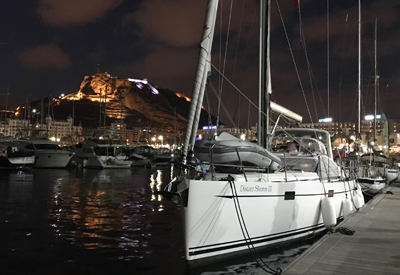
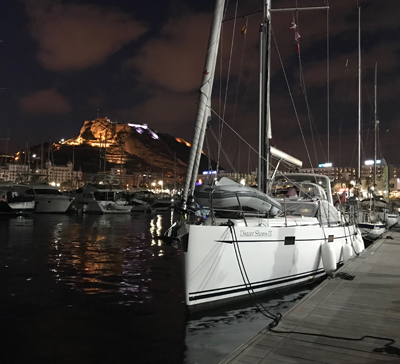 By Sheryl and Paul Shard
By Sheryl and Paul Shard
Distant Shores III at the dock at the Puerto América Marina in Cadiz, Spain. It is a very secure marina located in a rather unlovely industrial area but is a close walk to the beautiful ancient town of Cadiz.
This summer my husband, Paul, and I bought our fourth offshore cruising boat, a new Southerly 480 built by Discovery Yachts in the UK. It’s a unique boat with a retractable variable-draft swing keel giving you the option of sailing with a deep draft of 3.1 metres when the keel is down or just less than a metre with the keel fully retracted. Southerly Yachts are great for bluewater sailing and also for gunkholing in shallow creeks and inland waterways. You can even dry them out at low tide so they are is the perfect boat for the type of exploring we like to do. Our new boat, Distant Shores III, is the third Southerly Yacht that we’ve owned over 29 years of international cruising to destinations in the Caribbean, Mediterranean, Middle East, UK, Scandinavia and South America. This boat we plan to sail to the South Pacific.
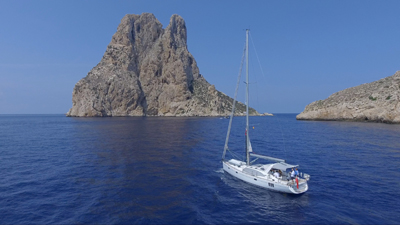 Debbie, Rick, Lori, Gokhan, Sheryl and Paul at the islet of Es Vedrá, Ibiza, in the Balearic Islands.
Debbie, Rick, Lori, Gokhan, Sheryl and Paul at the islet of Es Vedrá, Ibiza, in the Balearic Islands.
Before crossing any oceans however, it is prudent to give a new boat a serious shakedown. A shakedown cruise is a voyage of more than a couple of days where you do some hard sailing and use the boat in as many ways and in as many weather conditions as you can manage to reveal any problems and fix them before striking out across vast bodies of water or sailing to remote places where parts and services won’t be available.
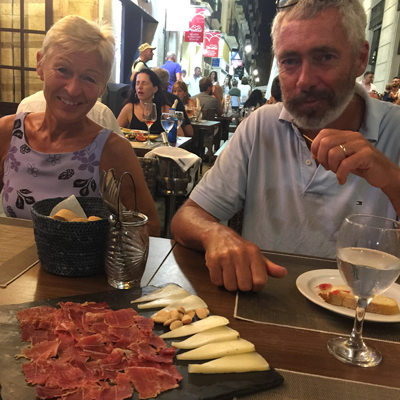 Norwegian crewmember and friend, Marianne, with Paul Shard sampling tapas at one of the many tapas restaurants in Alicante.
Norwegian crewmember and friend, Marianne, with Paul Shard sampling tapas at one of the many tapas restaurants in Alicante.
We had been doing sea trials with the boat along the South Coast of England in the spring when the boat was in final stages of commissioning by the manufacturer, and as a result most of the “snags” of new boat construction had been caught and addressed. These coastal shakedowns included a delightful sail up the Thames Estuary to Tower Bridge in downtown London to display the boat in the London In-Water Boat Show. This 3-day adventure gave the boat a good test before we took official delivery of Distant Shores III on June 21st, the summer solstice.
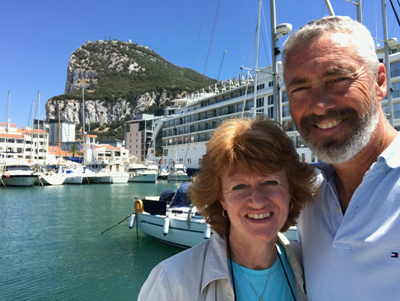 Sheryl and Paul Shard enjoy a day at the beach at Espalmador.
Sheryl and Paul Shard enjoy a day at the beach at Espalmador.
Now we needed to do an offshore shakedown.
A passage south from England to the Mediterranean was just the ticket! Many years ago we had cruised along the Atlantic and Mediterranean coasts of Spain with a couple of our previous boats. A return voyage to Spain would serve as a great shakedown and subsequent cruise along the Costa del Sol, Costa Blanca and out to the Balearic Islands would make for a wonderful summer cruise before leaving this part of the world for a while.
But first things first. Being Canadians, we had purchased our new boat non-VAT (i.e. without paying the European Value Added Tax since the boat would not remain in the EU) so our first sail as owners was a quick overnight passage from Southampton, England, across the English Channel to Guernsey in the Channel Islands, to export Distant Shores III out of Europe and officially register the boat. (The Channel Islands which lie off the coast of France are not part of the EU.) The whole procedure was handled by the very efficient yacht registration agents at OceanSkies.com in St. Peter Port, Guernsey. They met us at the dock the moment we arrived and the paperwork was completed within hours.
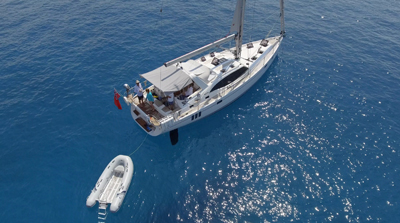 Distant Shores III anchored in Cala d’Egos near Andraxt. The pristine water of this and many calas (small bays) around Mallorca made for good swimming and snorkelling.
Distant Shores III anchored in Cala d’Egos near Andraxt. The pristine water of this and many calas (small bays) around Mallorca made for good swimming and snorkelling.
We had explored the Channel Islands on a previous cruise so, with weather conditions looking good, we set sail from Guernsey the next day to begin a 7-day passage south to Lisbon, Portugal, our first planned stop on our voyage towards the Mediterranean.
We had a variety of wind conditions throughout that initial passage with strengths from light to perky so we got lots of practice with our new in-mast furling mainsail, a beautiful Epex laminated sail by Elvstrøm which works beautifully with our Seldén mast. This combination had been recommended to us since the Seldén system has a good track record and the Epex laminated mainsail holds it shape really well which is important for smooth furling.
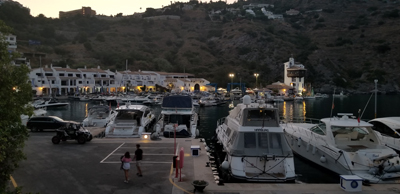 Marina del Este, one of the many well appointed marinas on Spain’s Costa del Sol.
Marina del Este, one of the many well appointed marinas on Spain’s Costa del Sol.
It was a big decision for us to go with in-mast furling on this boat since we had always had a traditionally rigged mainsail on our other boats but we are so glad we made the switch since the in-mast furling mainsail is really easy to reef in and out by one person. I didn’t have to wake Paul to help me reef or unreef when it was my night watch and since the whole procedure is done right from the cockpit it is very safe to do. We found we were sailing better and more often as a result. No reefing down at night “just in case”. Using it does take a little practice however. The secret to smooth furling is to always keep a little tension on the outhaul so the sail doesn’t flap when you take it in or out risking creasing and jamming. Our Epex mainsail has full vertical battens which ensures that the sail slides in and out of the slot in the mast crease-free.
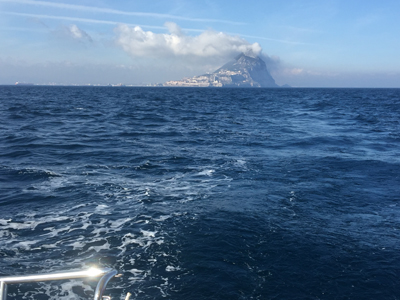 The Rock of the Gibraltar as seen over the stern of Distant Shores III as the Shards cross the Strait of Gibraltar to Ceuta, a Spanish enclave on the North African coast and the second fabled Pillar of Hercules.
The Rock of the Gibraltar as seen over the stern of Distant Shores III as the Shards cross the Strait of Gibraltar to Ceuta, a Spanish enclave on the North African coast and the second fabled Pillar of Hercules.
We also got the opportunity to do some downwind sailing so could use our two new Seldén downwind poles – one carbon, one aluminum (for weight and budget considerations) – to goose wing our jib and reacher. Again it took a little practice to set up both poles and set the sails, fore and aft guy right but that’s what a shakedown cruise is all about.
We had no mishaps except for one night off Cape Finisterre, Spain. The wind had dropped completely so we switched on the motor, our new Yanmar 4JH80, and purred along over glassy seas enjoying the company of a large pod of playful dolphins. Just at sunset the motor stopped dead. Oh no! We quickly made checks and tests as the boat wobbled around on the ocean swell and discovered to our dismay that we had a large rope caught in our brand new Varifold4 propeller! It looked like a piece of a ship’s hauser floating just below the surface and no matter how hard we pulled that rope it would not come off. By now the sun had set so it was too dark and dangerous to dive on the propeller. We’d have to wait until morning.
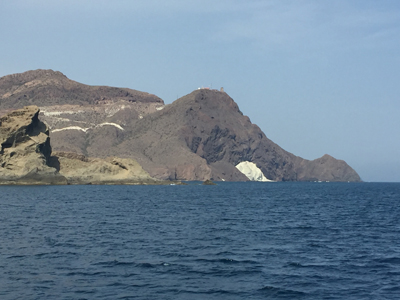 Round Cabo de Gata to head north along the Costa Blanca. The Cape is identified by the distinctive white rock amongst volcanic formations along this coast. There is a strong east-going current here that can be strong. It changes it’s direction to NE-going and weakens along the coast.
Round Cabo de Gata to head north along the Costa Blanca. The Cape is identified by the distinctive white rock amongst volcanic formations along this coast. There is a strong east-going current here that can be strong. It changes it’s direction to NE-going and weakens along the coast.
We spent an aimless night bouncing around on sloppy windless seas unable to sail and drifting with the tide, first towards the TSS (traffic separation scheme or shipping lanes) off Cape Finisterre (yikes!), and then towards the cape itself (yikes again!). Thankfully we were centrally positioned between the two so we experienced no danger from either through the night. To our surprise and delight the friendly pod of dolphins stayed with us throughout the dark hours of the night. Usually they lose interest if the boat is not moving but they played around us all night long, keeping the on-watch crew company with their chirps and twitters and splashing around the stern.
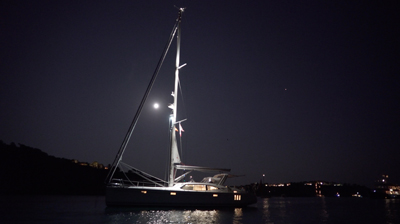 Distant Shores III at night on a guest mooring provided by the Club de Vela de Puerto de Andraxt.
Distant Shores III at night on a guest mooring provided by the Club de Vela de Puerto de Andraxt.
At first light I woke Paul and he started preparing to dive on the propeller but when he came on deck a strange thing happened. One of the dolphins slapped his tail against the side of the hull as if trying to get our attention! Never in our 29 years of international cruising has a dolphin ever touched the boat. The dolphins were really churning around the stern now chirping and splashing so we looked over to see with amazement that the long rope appeared to be gone! Was it true? Had our dolphin friends been playing at our stern through the night working at pulling the rope off? Paul got out our camera boom and put down our underwater camera to take a look to be sure. Yes, it was gone! And when we played back the video there was a dolphin pointing at the prop with his peak with what looked like a smile on his face. Magic. We gratefully motored on and with full sunrise the wind eventually picked up so we could sail,
We arrived at Marina Cascais, just outside of Portugal’s capital city of Lisbon, on July 3rd, where we had a couple of days to relax and clean up the boat before friends Lana and Lucian from Toronto arrived to join us on the next leg of our voyage along the Atlantic coast of Portugal and Spain to Gibraltar at the entrance to the Mediterranean Sea.
We had light winds but enough to sail as we proceeded south and rounded Cape São Vincent where in days of old the great Portuguese explorers set sail into unknown seas charting the oceans so that generations later simple seafarers like us could also travel the world on water.
 Crewmember, Rick Collins aboard Distant Shores III at Marina Hercules, Ceuta.
Crewmember, Rick Collins aboard Distant Shores III at Marina Hercules, Ceuta.
We made landfall in Spain on the Atlantic coast in the early morning of July 14th at the ancient city of Cadiz following a couple of good night passages. Check-in in Spain is handled by the marinas with paperwork forwarded to the proper authorities. In no time we were welcomed by the friendly marina manager and safely docked at the well-run Puerto América Marina. This secure modern marina is located in a rather unattractive industrial complex but attempts have been made to make a pleasant waterfront promenade to the nearby town which is within easy walking distance. We spent a couple of days exploring the streets of this delightful old city founded by the Phoenicians over 3,000 years ago. For many years Cadiz handled all the lucrative trade with the New World which led to great wealth as shown in the magnificent architecture.
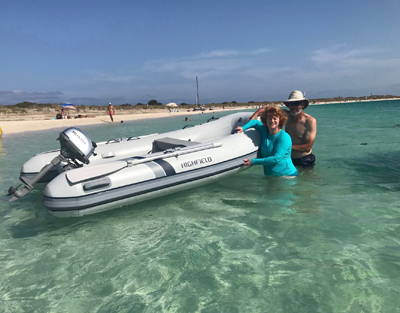 Sheryl and Paul Shard with their new Highfield inflatable at the beach in Espalmador. The dinghy has a tough aluminum floor and is very lightweight.
Sheryl and Paul Shard with their new Highfield inflatable at the beach in Espalmador. The dinghy has a tough aluminum floor and is very lightweight.
We made another night sail, this time from Cadiz to Gibraltar passing the shoals of the historic Cape Trafalgar where on October 21, 1805, British Admiral Lord Nelson met his end in the Battle of Trafalgar during the Napoleonic Wars. The Franco-Spanish fleet lost 22 ships and the British lost none. The 50m lighthouse here can be seen 22 miles away so its reassuring light was with us most of the night.
In daylight, with favourable tides, we entered the Strait of Gibraltar, the narrow neck joining the Atlantic Ocean to the Mediterranean Sea and arrived at Marina Bay Marina at the famous Rock of Gibraltar, one of the fabled Pillars of Hercules. Gibraltar is small British Overseas Territory with an area of 6.7 square km located at the southern tip of the Iberian Peninsula. It is a densely populated (30,000 people) duty-free port and with English spoken is a good place for English-speaking yachtsmen like us to stop and have work done by the skilled labour force there. We spent a couple of weeks in Gibraltar having a solar arch with incorporated bimini designed and worked on by Pritchards Marine and Ocean Canvas Gibraltar as well as some warranty work done by Sheppards Boatyard, all part of our preparation for our transatlantic crossing in the coming autumn.
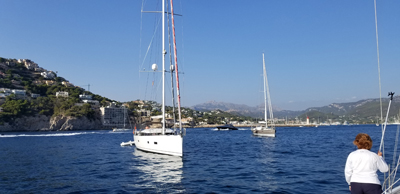 Coming into the amphitheatre-like harbour of Andraxt.
Coming into the amphitheatre-like harbour of Andraxt.
But in the meantime, we were looking forward to entering the Mediterranean Sea and re-exploring the Spanish coasts of Costa del Sol and Costa Blanca, then heading for the Balearic Islands.
For this next leg of the voyage we had friends, Malcolm and Anne from Canada and Frank and Marianne from Norway join us as crew. They all share our love of good wine, good food, good company and sailing so it was a jovial cruise together dayhopping along the Costa del Sol with restaurant and overnight stops at the resort marinas of Estepona (where they give you a complementary bottle of their red house wine when you check in), Fuengirola and Marina del Este where we compared Spanish paella and fresh seafood dishes from one to the other.
It was hot. This was the time of the 2-week heat wave that hit Spain and Portugal where inland temperatures reached 45 C. It was cooler on the water but not much. When possible we anchored and swam or doused ourselves with sea water as we sailed or motorsailed with the Sierra Nevada mountains shimmering in the distance as we made our way towards Cabo de Gata where we would turn north to follow the desertlike natural coast of Costa Blanca. There is little development here compared to the Costa del Sol and the area is a protected national park. We enjoyed anchoring and swimming along this coast except for one bouncy night and then Anne suggested we make a stop at the marina in Alicante, a Spanish town where friends of hers and Malcolms liked to spend the winter.
We had been watching for a weather window to make the overnight jump to the Balearic Islands, a popular Spanish cruising ground but since there were headwinds we all opted to go to Alicante where we had a good couple of days enjoying the many tapas restaurants, markets and nightly street musicians and entertainment. It was hard to leave.
We at last got our weather window for the Balearic Islands and had a good overnight sail to Formentera and the islet of Espalmador where we had reserved a mooring online. This was an improvement from previous visits we’d made in the ‘90s where anchoring conflicts were the norm in this crowded yet stunningly beautiful anchorage with its golden crescent beach. Following a relaxing day of beachcombing in Espalmador, we next made a daysail to the island of Mallorca where we made the Club de Vela de Puerto de Andraxt our base, swinging on a guest mooring in the charming harbour where we had a wide selection of many good restaurants, shops and chandleries. Just around the corner is the idyllic day anchorage of Cala d’Egos where we swam and cooled in the sparkling water.
Our friends left us here and we sailed around the island to the main city of Palma where at the upscale Reál Club Nautico de Palma we were to meet our next crewmembers, American/Turkish friends, Lori and Gokhan and Canadians Debbie and Rick, a fun-loving group who joined us on the return trip to Gibraltar where we added in a trip across the Strait of Gibraltar to the Spanish enclave of Ceuta on the North African coast, similar in size and population to Gibraltar, and the second Pillar of Hercules.
The next day we re-crossed the Strait and were back in Marina Bay in Gibraltar to say our farewells, do the final fitting of our new solar arch and prepare for a voyage to the Canary Islands of Spain. The boat was feeling ready after her summer shakedown and we were feeling strongly that special spirit of adventure that sailors worldwide can’t seem to shake.
***
Canadians Paul and Sheryl Shard have now sailed over 100,000 nm and have completed 8 ocean crossings as well as many hundreds of miles of offshore passage-making on the 4 boats they’ve owned, their latest a new Southerly 480. The Shards are award-winning filmmakers and television producers. Follow their adventures on the Distant Shores YouTube Channel where you can see video of this shakedown cruise of Spain and previous voyages at www.youtube.com/distantshores1.
– end –




























